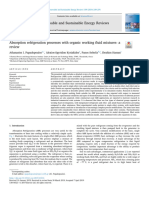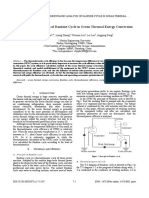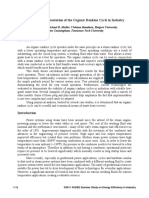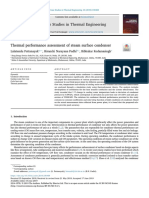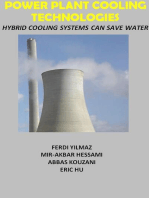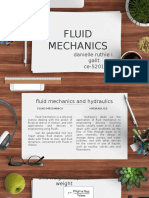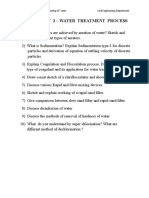Ojfd 2013120416111032
Ojfd 2013120416111032
Uploaded by
Sa JgCopyright:
Available Formats
Ojfd 2013120416111032
Ojfd 2013120416111032
Uploaded by
Sa JgOriginal Title
Copyright
Available Formats
Share this document
Did you find this document useful?
Is this content inappropriate?
Copyright:
Available Formats
Ojfd 2013120416111032
Ojfd 2013120416111032
Uploaded by
Sa JgCopyright:
Available Formats
Open Journal of Fluid Dynamics, 2013, 3, 302-310
Published Online December 2013 (http://www.scirp.org/journal/ojfd)
http://dx.doi.org/10.4236/ojfd.2013.34037
Performance Evaluation of Heat Exchangers in OTEC
Using Ammonia/Water Mixture as Working Fluid
Takafumi Morisaki, Yasuyuki Ikegami
Institute of Ocean Energy, Saga University, Saga, Japan
Email: 11634021@edu.cc.saga-u.ac.jp
Received September 4, 2013; revised October 4, 2013; accepted October 11, 2013
Copyright © 2013 Takafumi Morisaki, Yasuyuki Ikegami. This is an open access article distributed under the Creative Commons
Attribution License, which permits unrestricted use, distribution, and reproduction in any medium, provided the original work is
properly cited.
ABSTRACT
The ocean thermal energy conversion (OTEC) system is a promising solution to provide stable electricity supply. Al-
though the available temperature difference in OTEC systems is small, an ammonia/water mixture as working fluid is
expected to decrease irreversible losses in the heat exchangers and to improve system performance. However, in actual
heat exchangers, an adequate temperature crossing does not occur in the condenser but in the evaporator. Therefore,
clarification of this characteristic is important. To date, the logarithmic temperature difference (LMTD) method is used
in performance evaluations of OTEC heat exchangers. This method is of limited use if physical properties of fluids vary.
A generalized mean temperature difference (GMTD) method is introduced to perform this evaluation. As changes in
fluid property values can be considered in the GMTD method, method dependencies on heat exchanger characteristics,
effectiveness, and system characteristics can be studied. In particular, GMTD and LMTD using a pure substance were
found to be almost equal. Mean temperature differences using mixtures as working fluid were higher in the evaporator,
but lower in the condenser, from the GMTD method than from the LMTD method. For higher ammonia concentrations
in ammonia/water mixtures, the mean temperature differences from both methods are different.
Keywords: Ammonia/Water Mixture; Evaporation and Condensation Pressure; OTEC; GMTD; LMTD
1. Introduction Research is continuing on the Rankine cycle which is
the conventional closed-cycle process exploiting low-
Energy and environmental problems are becoming more
boiling-point working fluids such as ammonia. Using a
critical; the development of natural energy is desired.
pure substance as working fluid, the thermal efficiency of
Ocean thermal energy conversion (OTEC) using tem-
perature differences between warm surface seawater and the OTEC cycle increases with decreasing irreversible
cold deep seawater can supply stable electrical power [1] losses in the cycle or increasing effective temperature
integrated into a variety of applications, such as seawater difference, specifically the difference between evaporat-
desalination, residential cooling, and aquaculture [2-6]. ing and condensing temperatures of the working fluid.
In addition, the beneficial effects of OTEC systems on For that reason, it is necessary to decrease energy losses
global warming and energy shortage problems seem pro- in the heat exchangers, namely to decrease the tempera-
mising. Oceans have a huge amount of stored thermal ture difference between seawater and working fluid. This
energy, although, the energy density is low. As an OTEC is done by increasing the heat transfer area or the overall
system operates in conditions of small temperature dif- heat transfer coefficient. Using non-azeotropic mixtures
ferences, an appropriate working fluid must have a low such as ammonia/water as working fluids in the OTEC
boiling point if it is to be used in a closed-cycle OTEC. cycle was proposed by Kalina in 1982 [7]. Uehara et al.
The OTEC system requires warm water, cold seawater, [8] indicated that reducing the irreversible losses in heat
and a working fluid pump power; the ratio of the warm exchangers using non-azeotropic mixtures leads to im-
and cold water pump power to output power is compara- provements in the thermal efficiency of the cycle. Fur-
tively higher than that of conventional fossil power thermore, they focused on the Kalina cycle, and pre-
plants. sented a new cycle using the ammonia/water mixture [9].
Open Access OJFD
T. MORISAKI, Y. IKEGAMI 303
Several theoretical and experimental investigations have process between hot water and supercritical carbon di-
reported that thermal efficiency of such Kalina cycles is oxide as a working fluid. As a result, validity of the
higher than that of the Rankine cycle using pure ammo- GMTD method was proved. The GMTD is believed ap-
nia [10-15]. Other studies have reported that the effective plicable in the evaluation of heat exchangers using am-
temperature difference and heat transfer coefficient de- monia/water although properties of the mixture are quite
crease with changes in concentration in the boundary distinct. It is not clear whether the GMTD method is
layer during evaporation and condensation [16-18]. Pre- valid for heat exchangers using non-azeotropic mixtures
vious studies have investigated the operating conditions as working fluid.
and equipment of an experimental apparatus using am- In this paper, clarification is obtained on the charac-
monia/water mixtures to improve system performance. teristics of heat exchanger using ammonia/water mix-
Ikegami et al. [19] performed experiments to investigate tures in improving cycle performance, achieved with the
the influence of system performance on ammonia con- available methods of evaluation heat exchangers. A com-
centration in the mixture. The experiments were per- parison is made between LMTD and the recently devel-
formed to assess the stability of the ammonia/water mix- oped GMTD calculation methods as performed on the
ture power cycle [20]. The results from these experi- heat exchanger using ammonia/water mixture and the
ments showed that it is critically important to enhance applicability of the GMTD method is assessed.
the performance of the condenser in increasing the per-
formance of the total OTEC system. Furthermore, the 2. Temperature Change in Heat Exchangers
characteristics of the ammonia/water mixture cycle have with Ammonia/Water Mixture
not as yet been thoroughly clarified experimentally.
To enhance the ammonia/water mixture cycle, clarifi- In Figures 1(a) and (b), the distributions of the fluid
cation of the heat exchanger performance is extremely temperature within the heat exchanger is given as a func-
important. The traditional and effectual evaluation me- tion of distance (Δx) and heat flow rate (ΔQ), respec-
thod of heat exchanger performance is the logarithmic tively. The temperature variation of the ammonia/water
mean temperature difference (LMTD) method but appli- mixture changes in the heat exchanger owing to the large
cation of this method is limited to heat exchangers using difference between its boiling point and its dew point.
working fluids having constant heat transfer coefficient Consequently, an increase in available exergy of the sys-
and thermal properties. The generalized mean tempera- tem is expected with this mixture as working fluid. From
ture difference (GMTD) method however enables varia- Figure 1(a), the improvement in heat transfer perform-
tions in thermal properties in heat exchange processes to ance and the ratios of the working fluid temperature to
be included. Utamura et al. [21] first proposed the GMTD the heat source temperature in the evaporator and to the
method, and applied it to evaluate the heat exchange cold In Figures 1(a) and (b), the distributions of the fluid
30 14 30 14
Ammonia concentration : 0.95kg/kg Ammonia concentration : 0.95kg/kg
Evaporator Evaporator
Warm source Warm source
Working fluid Working fluid
28 12 28 12
Temperature at condenser TC [oC]
Temperature at condenser TC [oC]
Temperature at evaporator TE [oC]
Temperature at evaporator TE [oC]
26 10 26 10
24 8 24 8
22 6 22 6
Condenser Condenser
Working fluid Working fluid
Cold source Cold source
20 4 20 4
0 0.2 0.4 0.6 0.8 1 0 0.2 0.4 0.6 0.8 1
Length ratio x/x0 [m/m] Heat flow rate ratio Q/Q0 [W/W]
(a) (b)
Figure 1. Temperature change in heat exchangers. Relationships between temperature and (a) length ratio and (b) heat-
flow-rate ratio for evaporator and condenser.
Open Access OJFD
304 T. MORISAKI, Y. IKEGAMI
temperature within the heat exchanger is given as a func-
tion of distance (Δx) and heat flow rate (ΔQ), respec- TLMTD
THI TLO THO TLI . (1)
tively. The temperature variation of the ammonia/water ln THI TLO THO TLI
mixture changes in the heat exchanger owing to the large where THI, THO, TLI and TLO are the high and the low
difference between its boiling point and its dew point. temperature fluids heat exchanger inlet and outlet tem-
Consequently, an increase in available exergy of the sys- peratures.
tem is expected with this mixture as working fluid. From
Figure 1(a), the improvement in heat transfer perform- 2.2. Innovated Evaluation Method
ance and the ratios of the working fluid temperature to
the heat source temperature in the evaporator and to the For an improved evaluation, it is necessary to consider
cold source temperature in the condenser are important variations in the thermophysical properties that better
when considering enhancing cycle performance. From reflect conditions within actual heat exchangers. There-
Figure 1(b), the working fluid temperature is a convex fore, the calculation results of LMTD are compared with
curve of the heat flow rate. The working fluid tempera- those of GMTD and assessed. Using Figure 2, the heat
ture approaches the warm water temperature in the inlet flow rate for the heat exchanger, dQ from x to x + dx, is
and outlet of evaporator but approaches the cold water calculated using:
temperature in the middle of the condenser. The pinch- dQ U i dAi T . (2)
point in particular is not well determined by the inlet and
outlet temperatures in condenser. In addition, the tradi- where Ui represents the overall heat transfer coefficient
tional evaluation method underestimates heat transfer for the ith segment, mass flow rate of the warm or cold
performance. Hence, the GMTD method, which accounts source, dAi is the heat transfer surface area, and ΔT is the
for the variation in the thermal properties, has been in- temperature difference between high- and low-tempera-
troduced for this performance evaluation. In contrast, for ture fluids. Integrating equation over all segments of the
a pure ammonia working fluid, temperatures are constant exchanger yields
in these heat exchangers because the thermal properties
dQ T Q 0 U i dAi .
Q0 Ai
are stable. 0 (3)
Then, the GMTD ΔTGMTD is defined as follows [21]:
2.1. Traditional Evaluation Method
1 TGMTD 1 Q0 0 dQ T Q .
Q0
(4)
The LMTD method has traditionally been used to evalu-
ate the temperature difference between the heat source The temperature integral is approximated as:
and the working fluid in a heat exchanger. The LMTD M
dQ T Q 2q T j T j 1 .
Q0
method is used only when the thermophysical properties 0 (5)
of the local fluid in the heat exchanger and the overall j 1
heat transfer coefficient are constant. Hence, the fluid in Therefore, the GMTD is calculated by:
the heat exchanger undergoes temperature changes as M
shown in Figure 2 with the horizontal axis conceptually TGMTD M 2 T j T j 1 . (6)
representing the length. The LMTD method is expressed j 1
as follows:
3. Comparison between Pure Ammonia and
T Ammonia/Water Mixture
THI Figure 3 shows the correlation between GMTD and
TH (x) LMTD for the evaporator and the condenser calculated
for both pure ammonia and ammonia/water mixture as
dQ ΔTM
working fluid. The evaporator and the condenser are
THO ΔTj+1 counter-flow-type heat exchangers; both warm and cold
ΔTj TLO sources are water; for the warm water, the inlet tempera-
ΔT0 TL (x) ture is 28˚C, and the outlet temperature is 25˚C; for the
cold water, the inlet temperature is 5˚C, and the outlet
TLI temperature is 8˚C. For pure ammonia, the evaporation
dA
temperature varied from 27.5˚C to 26.0˚C; the condensa-
tion temperature varied from 5.5˚C to 7.0˚C. For the am-
x monia/water mixture, the temperature at the evaporator
Figure 2. Fluid temperatures in the counter-flow heat. inlet varied from 27.5˚C to 26.0˚C, and at the evaporator
Open Access OJFD
T. MORISAKI, Y. IKEGAMI 305
3 PE of the working fluid, in the evaporator with the mass-
Generalized mean temperature difference TGMTD [K]
flow-rate ratio of working fluid to warm source. Here PE
TWFEI = 26.0oC
TWFEI = 26.5 oC
is defined as the maximum evaporation pressure of the
2.5
TWFEI = 27.0 oC working fluid, Pmax for these calculation settings. Figure
TWFEI = 27.5 oC 4(b) shows the mean temperature difference between the
2 ammonia/water mixture and cold water for both LMTD
and GMTD methods as well as the conden sation pres-
sure of the working fluid, PC, in the condenser against the
1.5 TWSI = 28 [oC] mass-flow-rate ratio of working fluid to cold source. The
TWSO = 25 [oC] condensation pressure, PC is defined as the minimum
TCSI = 5 [oC] condensation pressure of the working fluid, Pmin for these
1 TCSO = 8 [oC] calculation settings. The same settings for the inlet and
TWFCI = 7.0 oC TWF [oC] outlet temperatures for evaporator and condenser de-
2.0
0.5 TWFCI = 6.5 oC 1.5 scribed in Section 3 apply here. The ammonia concentra-
1.0 tion in the mixture is 0.95 kg/kg; the mass-flow-rate ratio
TWFCI = 6.0 oC 0.5 of working fluid to heat source, γ varied from 1.0 × 10−3
to 5.0 × 10−2. The temperature difference at the pinch-
0 0.5 1 1.5 2 2.5 3
Logarithmic mean temperature difference TLMTD [K] point is 0.5˚C. The working fluid is also assumed to be
saturated liquid at the evaporator inlet and saturated va-
Figure 3. Temperature change in heat exchangers. por at the condenser outlet. The physical properties of am-
monia/water mixture are evaluated using the M-PRO-
the outlet temperature varied from 24.5 to 23.0; the tem- PATH database [22].
perature at the condenser inlet varied from 6.0˚C to 7.0˚C, The mean temperature difference is higher in the eva-
and at the condenser outlet varied from 8.5˚C to 10.0˚C; porator from the GMTD method than from the LMTD
the ammonia concentration is 0.95 kg/kg. The working method at low flow-rate ratios (Figure 4(a)). The pinch-
fluids are assumed to be saturated liquid at the evaporator point appears at the evaporator inlet and outlet, reflecting
inlet and outlet, and saturated vapor at the condenser the convex downward nature of the variation of the
outlet and inlet. The physical properties of ammonia are working fluid temperature compared with the warm wa-
evaluated using the P-PROPATH database, and those of ter temperature. The convexity of the working fluid tem-
ammonia/water mixture are evaluated using the M-PRO- perature changes strongly when the temperature differ-
PATH database (Ibrahim and Kelein) [22]. ence of the working fluid between the evaporator inlet
The mean temperature differences between pure am- and outlet increases. The maximum pressure decreases
monia and heat source from the LMTD method and with decreasing mass-flow-rate ratio at low flow-rate
GMTD method are almost equal, as seen in Figure 3. In ratio, that is, 1.64 × 10−2 or less under these calculation
contrast, the mean temperature difference between am- conditions, because of the increasing working fluid tem-
monia/water mixture and heat source is higher in the
perature difference between evaporator inlet and outlet.
evaporator from the GMTD method than from the
In contrast, the mean temperature differences from
LMTD method, but lower in the condenser. The variation
GMTD and LMTD methods are almost equal at the high
of working fluid temperature with heat-flow-rate ratio
flow-rate ratios. The convexity of the working fluid tem-
produces a convex downward curve, as seen in Figure
perature is not strong at the high flow rate ratio, that is,
1(b). For the evaporator, the working fluid temperature
5.0 × 10−2 or more under these calculation settings, be-
approaches the warm water temperature at the evaporator
cause the working fluid temperature difference between
inlet and outlet. The mean temperature difference is
evaporator inlet and outlet is small.
higher in the evaporator from the GMTD method than
Figures 5(a) and (b) shows an example where there
from the LMTD method. For the condenser, the working
are variations in the working fluid and warm water tem-
fluid temperature approaches the cold water temperature
peratures in the evaporator at heat-flow-rate ratio of 0.80
of the condenser. The mean temperature difference with
kg/kg and 0.95 kg/kg ammonia concentration, respec-
the GMTD is lower than that with the LMTD method.
tively, and the temperature difference at the pinch-point
is 0 K. The working fluid temperature curve against heat
4. Mass-Flow-Rate Ratio Dependencies from
flow rate is convex downward. Its slope rises gradually
GMTD and LMTD Models
as the ammonia concentration in the mixture increases.
Figure 4(a) shows the mean temperature difference be- The path between the working fluid outlet temperature
tween ammonia/water mixture and warm water from the and warm source inlet temperature is defined as “State
LMTD and GMTD methods and the evaporation pressure A”. The mass-flow-rate ratio for “State A” is under 1.64
Open Access OJFD
306 T. MORISAKI, Y. IKEGAMI
5 1 5 0.58
Maximum Pressure with GMTD method Pmax [MPa]
Minimum Pressure with GMTD method Pmin [MPa]
Condenser
Pressure
Mean temperature difference T [K]
LMTD
Mean temperature difference T [K]
4 Evaporator 0.8 4 0.56
GMTD
Pressure
LMTD
3 GMTD 0.6 3 0.54
TWSI = 28 [oC]
TWSO = 25 [oC]
y = 0.95 [kg/kg]
2 0.4 2 0.52
1 0.2 1 0.5
TCSI = 5 [oC] TCSO = 8 [oC]
y = 0.95 [kg/kg]
0 0.48
0 0.01 0.02 0.03 0.04 0.05 0 0.01 0.02 0.03 0.04 0.05
Flow rate ratio of working fluid on warm source Flow rate ratio of working fluid on cold source
(=mWF /mWS) [-] (=mWF /mCS) [-]
(a) (b)
Figure 4. Temperature change in heat exchangers. (a) Evaporator; (b) Condenser.
31 31
Warm seawater Warm seawater
State A State A
30 State B 30 State B
State C State C
Y = 0.80 [kg/kg] Y = 0.95 [kg/kg]
Temperature T [oC]
Temperature T [oC]
29 29
28 28
27 27
26 26
25 25
0 20 40 60 80 100 0 20 40 60 80 100
Heat flow rate ratio Q/Q0 [W/W] Heat flow rate ratio Q/Q0 [W/W]
(a) (b)
Figure 5. Temperature change in the evaporator. (a) Y = 0.80 kg/kg; (b) Y = 0.95 kg/kg.
× 10−2. A similar path at the evaporator inlet and outlet, condenser, the working fluid is high temperature fluid,
defined as “State B”, has mass-flow-rate ratio of 1.64 × and the cold water is low temperature fluid. A pinch-
10−2, and the mean temperature differences from the point appears as a consequence of convex downward
GMTD and LMTD methods are minimal. The path be- variation in the working fluid temperature compared with
tween the working fluid inlet temperature and warm that for the cold water temperature. Similar to the con-
source outlet temperature is defined as “State C”. The vexity in the working fluid temperature in the evaporator,
variation in the maximum pressure is constant because at the temperature in the condenser changes when the tem-
evaporator inlet the working fluid is saturated liquid. The perature difference of the working fluid between the con-
mass-flow-rate ratio for “State C” exceeds 1.64 × 10−2. denser inlet and outlet increases. Therefore, the minimum
The mean temperature difference is lower from the pressure decreases gradually with decreasing mass-flow-
GMTD method than from the LMTD method at low rate ratio. The mean temperature differences from the
flow-rate ratios in the condenser (Figure 4(b)). For the GMTD and LMTD methods are almost equal at high-
Open Access OJFD
T. MORISAKI, Y. IKEGAMI 307
flow-rate ratios, that is, 5.0 × 10−2 or more with these show the dependence of the maximum pressure in the
calculation settings, because the working fluid temper- evaporator on the mass-flow-rate ratio of working fluid
ature difference between evaporator inlet and outlet is to warm source. Similarly, Figures 8(a) and (b) show the
small. dependence of minimum pressures for the condenser on
Figures 6(a) and (b) show as a further example with the mass-flow-rate ratio of working fluid to cold source.
property variations in the working fluid, the cold water The same calculation settings as describe above in Sec-
temperatures in the condenser against heat-flow-rate ratio tion 3 are used. The mass-flow-rate ratio of the working
at ammonia concentration of 0.80 kg/kg and 0.95 kg/kg, fluid with heat source varied from 1.0 × 10−3 to 5.0 ×
respectively, when the temperature difference of the 10−2. Again, the working fluid is saturated liquid at the
pinch-point is 0 K. The path between the working fluid evaporator inlet and saturated vapor at the condenser
outlet temperature and cold source inlet temperature is outlet. The physical properties of ammonia/water mixture
defined as “State A”. The variation of the minimum are evaluated using the M-PROPATH database [8]. The
pressure is constant from the assumption that the work- ammonia concentration in the mixture varied from 0.99
ing fluid is saturated liquid at the condenser outlet. The to 0.80 kg/kg in Figures 7(a) and 8(a). The warm water
mass-flow-rate ratio for “State A” is 4.4 × 10−3 or less. temperature at the evaporator outlet varied from 27˚C to
Similarly, the path between the working fluid outlet 24˚C in Figure 7(b). The cold water temperature at the
temperature and warm source temperature in the con- condenser outlet varied from 6˚C to 9˚C in Figure 8(b).
denser is defined as “State B”. The pinch-point for “State The convexity of the working fluid temperature
B” is transferred from the cold water condenser outlet to changes strongly when the ammonia concentration in the
the inlet when the mass-flow-rate ratio decreases. The mixture increases (Figures 5(a) and (b)). For “State A”,
mass-flow-rate ratio for “State B” is from 4.5 × 10−3 to the maximum pressure decreases gradually at low am-
1.96 × 10−2. The mean temperature difference from the monia concentrations compared with high ammonia
GMTD method is a minimum when the mass-flow-rate concentrations as mass-flow-rate ratio decreases. In con-
ratio is 1.53 × 10−2, but the minimum from the LMTD trast, the mass-flow-rate ratio for “State B” increases
method occurs when the mass-flow-rate ratio is 1.85 × with increasing warm water temperature difference be-
10−2. The path between the working fluid inlet tempera- tween evaporator inlet and outlet.
ture and warm source outlet temperature is defined as Like convexity for the working fluid temperature in
“State C”. From the GMTD method, the mean tempera- the evaporator, that in the condenser changes when the
ture difference is lower for “State B” in the condenser. ammonia concentration in the mixture increases, (Fig-
The mass-flow-rate ratio for “State C” is 1.97 × 10−2 or ures 6(a) and (b)). Therefore, the mass-flow-rate ratio
more. for “State B” increases with decreasing ammonia con-
centration. The slope of the cold water temperature curve
5. Ammonia Concentration and Cold Source is steep when the cold water temperature difference be-
Temperature Dependencies from GMTD tween the condenser inlet and outlet increases. The range
and LMTD Models for “State B” increases as the cold water temperature
Obtained using the GMTD method, Figures 7(a) and (b) difference increases because the pinch-point at “State B”
10 10
9 9
Temperature T [oC]
Temperature T [oC]
8 8
7 7
6 Y = 0.80 [kg/kg] 6 Y = 0.95 [kg/kg]
State A State A
5 State B 5 State B
State C State C
Cold source Cold source
4 4
0 0.2 0.4 0.6 0.8 1 0 0.2 0.4 0.6 0.8 1
Heat flow rate ratio Q/Q0 [W/W] Heat flow rate ratio Q/Q0 [W/W]
(a) (b)
Figure 6. Temperature change in the condenser. (a) Y = 0.80 kg/kg; (b) Y = 0.95 kg/kg.
Open Access OJFD
308 T. MORISAKI, Y. IKEGAMI
1.2 1.2
State C State B State C
1 State B 1
Maximum Pressure Pmax [MPa]
Maximum Pressure Pmax [MPa]
0.8 0.8
State A
State A
0.6 0.6 GMTD method
TWSI = 28 [oC]
GMTD method y = 0.95 [kg/kg]
0.4 TWSI = 28 [oC] 0.4
TWSO = 25 [oC] Pmax TWSO [oC]
27
Pmax Y [kg/kg] Pmax Y [kg/kg]
0.2 0.99 0.85 0.2 26
0.95 0.80 25
0.90 24
0 0.01 0.02 0.03 0.04 0.05 0 0.01 0.02 0.03 0.04 0.05
Flow rate ratio of working fluid on warm source Flow rate ratio of working fluid on warm source
(=mWF /mWS) [-] (=mWF /mWS) [-]
(a) (b)
Figure 7. Maximum evaporation pressure. (a) Ammonia concentration; (b) Warm source outlet temperature.
0.6 0.6
0.55 0.55
Minimum Pressure Pmin [MPa]
Minimum Pressure Pmin [MPa]
State C
0.5 0.5 State C
State B
0.45 0.45
State A State A State B
0.4 GMTD method 0.4
TCSI = 5 [oC] TCSO = 8 [oC] Pmin TCSO [oC]
9
Pmin Y [kg/kg] Pmin Y [kg/kg]
0.35 0.99 0.85 0.35 GMTD method 8
0.95 0.80 TCSI = 5 [oC] 7
0.90 y = 0.95 [kg/kg] 6
0.3 0.3
0 0.01 0.02 0.03 0.04 0.05 0 0.01 0.02 0.03 0.04 0.05
Flow rate ratio of working fluid on cold source Flow rate ratio of working fluid on cold source
(=mWF /mCS) [-] (=mWF /mCS) [-]
(a) (b)
Figure 8. Maximum condensation pressure. (a) Ammonia concentration; (b) Cold source outlet temperature.
is transferred from the cold water condenser outlet to the GMTD and LMTD methods when the ammonia concen-
inlet. tration in the mixture increases.
The correlation between the mean temperature differ-
ences from both GMTD and LMTD methods plotted in 6. Conclusions
Figures 7(a) and 8(a) is presented in Figure 9; the bro-
ken line refers to an ammonia concentration of 0.99 To obtain reliable data on the characteristics of a heat
kg/kg, the chain line to 0.90 kg/kg, and the two-dot chain exchanger that uses ammonia/water mixture as working
line to 0.80 kg/kg; the circles refers to a mass-flow-rate fluid, the recently developed GMTD method, which is to
ratio of 5.0 × 10−2, the black circle 3.0 × 10−2, and the replace the traditional LMTD method, was assessed for
rectangle 2.0 × 10−2. The convexity of the working fluid validity in application. The conclusions are as follows:
temperature changes strongly when ammonia concentra- 1) Mean temperature differences between pure ammo-
tion in the mixture increases (Figures 5 and 6). There- nia and water obtained with the LMTD and GMTD
fore, the mean temperature difference differs between the methods are almost equal. In contrast, the evaluation of
Open Access OJFD
T. MORISAKI, Y. IKEGAMI 309
4 when the cold water temperature difference between the
Generalized mean temperature difference TGMTD [K]
TWSI = 28 [oC] condenser inlet and outlet increases. The range of “State
TWSO = 25 [oC] B” increases with increasing the cold water temperature
Evaporator [-]
TCSI = 5 [oC]
TCSO = 8 [oC]
5.010-2 difference because the pinch-point for “State B” is trans-
3.010-2
3 2.010-2 ferred from the cold water condenser outlet to inlet.
Y [kg/kg] Hence, the GMTD method can be applied to cycle cal-
0.99 culations of power plants and refrigeration systems using
0.90
0.80 ammonia/water mixture. Further research into compati-
2 bility conditions and accuracy of the GMTD method will
be carried out.
Condenser
1 REFERENCES
[1] A. H. A. William and W. Chih, “Renewable Energy from
the Ocean: A Guide to OTEC,” Oxford University Press,
New York, 1994.
0 1 2 3 4 [2] Y. Ikegami and H. Uehara, “Conceptual Design of Ocean
Logarithmic mean temperature difference TLMTD [K] Thermal Energy Conversion (OTEC) Power Plants in Sri
Lanka,” Proceedings of the 8th International Society of
Figure 9. Relationship between GMTD and LMTD. Offshore and Polar Engineers, 1998, pp. 140-148.
[3] Y. Ikegami and H. Uehara, “Optimum Design Point for a
heat exchange using ammonia/water mixtures using the Closed-Cycle OTEC System,” Proceedings of the 4th In-
LMTD method was unsatisfactory. Temperatures in the ternational Society of Offshore and Polar Engineers,
ammonia/water mixture differ from warm water tem- 1994, pp. 383-389.
peratures in the evaporator, and only approach cold water [4] F. Sun, Y. Ikegami, B. Jia and H. Arima, “Optimization
temperatures in the condenser. Design and Exergy Analysis of Organic Rankine Cycle in
2) Mean temperature differences are higher in the Ocean Thermal Energy Conversion,” Applied Ocean Re-
evaporator and lower in the condenser from the GMTD search, Vol. 35, 1994, pp. 383-389.
method than from the LMTD method, because the con- [5] N. Yamada, A. Hoshi and Y. Ikegami, “Performance Si-
vexity of ammonia/water mixture temperature changes mulation of Solar-Boosted Ocean Thermal Energy Con-
strongly as ammonia concentration increases. From the version Plant,” Renewable Energy, Vol. 34, No. 7, 2009,
pp. 1752-1758.
GMTD method, the mean temperature difference is lo- http://dx.doi.org/10.1016/j.renene.2008.12.028
wer when the working fluid temperature approaches the
[6] F. Sun, Y. Ikegami and B. Jia, “A Serformance Simula-
cold water temperature in the condenser. tion of Solar-Boosted Ocean Thermal Energy Conversion
3) For “State A”, the maximum pressure in the evapo- Plant,” Renewable Energy, Vol. 41, 2012, pp. 220-219.
rator decreases with decreasing mass-flow-rate ratio of [7] A. I. Kalina, “Generation of Energy by Means of a
ammonia/water mixture to water, owing to an increase in Working Fluid, and Regeneration of a Working Fluid,”
the temperature difference between the evaporator inlet United States Patent 4346561, 1982.
and outlet. In contrast, the variation in the maximum [8] H. Uehara and Y. Ikegami, “Parametric Performance
pressure is constant at “State C” because the working Analysis of Otec Using Kalina Cycle,” ASME, 1993, pp.
fluid is assumed to be saturated liquid at evaporator inlet. 203-207.
The maximum pressure decreases with decreasing am- [9] H. Uehara, Y. Ikegami and T. Nishida, “Performance Ana-
monia concentration in the mixture. lysis of OTEC System Using a Cycle with Absorption
4) The variation in the minimum pressure in the con- and Extraction Processes,” Transactions of the Japan So-
denser is constant assuming that the working fluid at ciety of Mechanical Engineers, Series B, 64-624, 1998, pp.
384-389.
condenser outlet is saturated liquid. The pinch-point for
“State B” is transferred from the cold water condenser [10] G. Wall, C. C. Chuang and M. Ishida, “Exergy Study of
the Kalina Cycle,” American Society of Mechanical En-
outlet to the inlet as the mass-flow-rate ratio decreases.
gineers (ASME), 10-15, 1989.
Therefore, the minimum pressure for “State B” decreases
[11] Y. M. El-Sayed and M. A. Tribud, “Theoretical Com-
with decreasing mass-flow-rate ratio. At low mass-flow-
parison of the Rankine and Kalina cycles,” ASME Publi-
rate ratios, the minimum pressure for “State C” decreases cation, 1, 1985, pp. 97-102.
gradually with decreasing the mass-flow-rate ratio that
[12] V. P. Pall and L. Eliasson, “Factors Influencing the Eco-
reflects the convex downward behavior of the working nomics of the Kalina Power Cycle and Situations of Su-
fluid temperature compared with the cold water tem- perior Performance,” International Geothermal Confer-
perature. The slope of the cold water temperature is steep ence, 2003, pp. 32-40.
Open Access OJFD
310 T. MORISAKI, Y. IKEGAMI
[13] M. D. Mirolli, “Cementing Kalina Cycle Effectiveness, [18] C. B. Panchal, D. L. Hillis, J. J. Lorenz and D. T. Yung,
the Kalina Cycle for Cement Kiln Waste-Heat-Recovery “OTEC Performance Tests of the Trane Plate-Fin Heat
Power Plants,” IEEE Industry Applications Magazine, Exchanger,” Ocean Thermal Energy Conversion Program
Vol. 12, No. 4, 2006, pp. 60-64. Argonne National Laboratory, 1981.
http://dx.doi.org/10.1109/MIA.2006.1678332 [19] Y. Ikegami, H. Goto, T. Morisaki and T. Furukawa, “Ef-
[14] U. R. Nasruddin, M. Rifaldi and A. Noor, “Energy and fect of Working Fluid Flow Rate and Ammonia Concen-
Exergy Analysis of Kalina Cycle System (KCS) 34 with tration on OTEC Using Ammonia/Water Mixture as
Mass Fraction Ammonia-Water Mixture Variation,” Me- Working Fluid,” 13th Asian Congress of Fluid Mechanics,
chnical Science and Technology, Vol. 23, No. 7, 2009, pp. 2010, pp. 1026-1029.
1871-1876. http://dx.doi.org/10.1007/s12206-009-0617-8 [20] Y. Ikegami, K. Urata, J. Inadomi, H. Goto, T. Morisaki,
[15] Z. Guzovic, D. Loncar and N. Ferdelji, “Possibilities of K. Inoue and S. Goto, “Investigation on the Stability of
Electricity Generation in the Republic of Croatia by OTEC System Using Ammonia/Water Mixture as Work-
Means of Geothermal Energy,” Energy, Vol. 35, No. 8, ing Fluid by Continuous Operation for Two Weeks,” Pro-
2010, pp. 3429-3440. ceedings of the 20th International Society of Offshore and
http://dx.doi.org/10.1016/j.energy.2010.04.036 Polar Engineers, 2010.
[16] K. E. Starling, D. W. Johnson, H. Hafezzadeh, L. W. Fish, [21] M. Utamura, K. Nikitin and Y. Kato, “Generalization of
H. H. West and K. Iqbal, “Use of Mixtures as Working Logarithmic Mean Temperature Difference Method for
Fluids in Ocean Thermal Energy Conversion Cycles— Heat Exchanger Performance Analysis,” Thermal Science
Phase I,” US DOE Report, 1974. & Engineering, Vol. 15, No. 3, 2007, pp. 163-172.
[17] K. E. Starling, D. W. Johnson, H. Hafezzadeh, L. W. Fish, [22] PROPATH Group, “A Program Package of Thermo-
H. H. West and K. Iqbal, “Use of Mixtures as Working Physical Properties of Fluids, Version 11.1,” PROPATH
Fluids in Ocean Thermal Energy Conversion Cycles— Group.
Phase II,” US DOE Report, 1978.
Open Access OJFD
You might also like
- Fluid Selection For The Organic Rankine Cycle (ORC) in Biomass Power and Heat Plants PDFDocument6 pagesFluid Selection For The Organic Rankine Cycle (ORC) in Biomass Power and Heat Plants PDFChairunnisa NisaNo ratings yet
- The Water Technology Sector in The USDocument68 pagesThe Water Technology Sector in The USashry09No ratings yet
- Thermodynamic Performance Analysis of Different Organic Rankine Cycles To Generate Power From Renewable Energy ResourcesDocument8 pagesThermodynamic Performance Analysis of Different Organic Rankine Cycles To Generate Power From Renewable Energy ResourcesAndhdNo ratings yet
- OTEC Rankine AnalysisDocument8 pagesOTEC Rankine AnalysisJoseph Liev Barraza DiazNo ratings yet
- Mayi Et Al.Document16 pagesMayi Et Al.Lekane nelsonNo ratings yet
- Exergetic Sensitivity Analysis of ORC Geothermal Power Plant Considering Ambient TemperatureDocument8 pagesExergetic Sensitivity Analysis of ORC Geothermal Power Plant Considering Ambient TemperatureMatheus M. DwinantoNo ratings yet
- 11 - Chapter 2 - 2Document15 pages11 - Chapter 2 - 2rahulNo ratings yet
- Gethermie ORCDocument7 pagesGethermie ORCSyaiful FuadNo ratings yet
- 10 26701-Ems 644733-1070465Document6 pages10 26701-Ems 644733-1070465Boubacar FofanaNo ratings yet
- Energy: Huijuan Chen, D. Yogi Goswami, Muhammad M. Rahman, Elias K. StefanakosDocument7 pagesEnergy: Huijuan Chen, D. Yogi Goswami, Muhammad M. Rahman, Elias K. StefanakosSyaiful NasutionNo ratings yet
- A Novel Design Approach For Small Scale Low Enthalpy Binary GeothermalDocument10 pagesA Novel Design Approach For Small Scale Low Enthalpy Binary GeothermalDidit Setyo PamujiNo ratings yet
- Comparison of Optimum Operating Conditions For A Combined Power and Cooling Thermodynamic CycleDocument13 pagesComparison of Optimum Operating Conditions For A Combined Power and Cooling Thermodynamic CycleHarits Eka FebriyantoNo ratings yet
- Evaluation of Multi-Step Thermochemical Processes For The Production of Hydrogen From WaterDocument2 pagesEvaluation of Multi-Step Thermochemical Processes For The Production of Hydrogen From Wateramirfirdausahmad3No ratings yet
- Análisis de Rendimiento Termodinámico de Diferentes Ciclos Orgánicos de Rankine para Generar Energía A Partir de Recursos de Energía Renovable.Document9 pagesAnálisis de Rendimiento Termodinámico de Diferentes Ciclos Orgánicos de Rankine para Generar Energía A Partir de Recursos de Energía Renovable.ManuNo ratings yet
- Barkhor Darian 2017Document11 pagesBarkhor Darian 2017Trân Phạm Thị HuếNo ratings yet
- Experimental Comparison of Heat Transfer in A Down Flow Louvered Fin Auto Radiator Using Water, Water and Ethylene Glycol Mixture & Water, Ethylene Glycol and Sugarcane Juice Mixture As CoolantsDocument9 pagesExperimental Comparison of Heat Transfer in A Down Flow Louvered Fin Auto Radiator Using Water, Water and Ethylene Glycol Mixture & Water, Ethylene Glycol and Sugarcane Juice Mixture As CoolantsJuan Sebastian Ramirez MartinezNo ratings yet
- 294782214Document10 pages294782214alnagealtayb77No ratings yet
- 1 s2.0 S1359431120331288 MainDocument10 pages1 s2.0 S1359431120331288 MainSharik DuarteNo ratings yet
- Zarrougui 2015Document17 pagesZarrougui 2015Cecilia BelanoNo ratings yet
- Thermodynamic Analysis of Vapour Absorption Refrigeration System Using Solar EnergyDocument10 pagesThermodynamic Analysis of Vapour Absorption Refrigeration System Using Solar EnergyAmanuelNo ratings yet
- 15 IJTPE Issue26 Vol8 No1 Mar2016 pp88 94Document7 pages15 IJTPE Issue26 Vol8 No1 Mar2016 pp88 94Siti nur azizahNo ratings yet
- Absorption Refrigeration Processes With Organic Working Fluid Mixtures - A ReviewDocument32 pagesAbsorption Refrigeration Processes With Organic Working Fluid Mixtures - A Review16-11206No ratings yet
- BHT of AmmoniaDocument12 pagesBHT of AmmoniaVipin NairNo ratings yet
- Energies 10 00440 v3Document21 pagesEnergies 10 00440 v3AAli ManaNo ratings yet
- Thermodynamic Analysis of Rankine Cycle in Ocean Thermal Energy ConversionDocument4 pagesThermodynamic Analysis of Rankine Cycle in Ocean Thermal Energy ConversionKumar KumarNo ratings yet
- 10.1016@j.ijheatmasstransfer.2019.05.057Document10 pages10.1016@j.ijheatmasstransfer.2019.05.057lyswysy200No ratings yet
- Improving Steam Power Plant Efficiency Through Exergy Analysis: Ambient TemperatureDocument4 pagesImproving Steam Power Plant Efficiency Through Exergy Analysis: Ambient TemperatureRizki KumbangNo ratings yet
- Documento 1Document6 pagesDocumento 1Tatiana BarragánNo ratings yet
- Zolfagharkhani 2018Document11 pagesZolfagharkhani 2018HendNo ratings yet
- Singh 2017Document9 pagesSingh 2017Lekane nelsonNo ratings yet
- Heat Transfer and Flow Characteristics of Hybrid Al O /tio Water Nanofluid in A Minichannel Heat SinkDocument11 pagesHeat Transfer and Flow Characteristics of Hybrid Al O /tio Water Nanofluid in A Minichannel Heat SinkbasharaltaeeeyNo ratings yet
- Thermodynamic Modelling of A Single-Effect Absorption CycleDocument14 pagesThermodynamic Modelling of A Single-Effect Absorption CyclealbertoNo ratings yet
- Performance optimization and parametric evaluation of the cascade vapor compression refrigeration cycle using Taguchi and ANOVA methodsDocument12 pagesPerformance optimization and parametric evaluation of the cascade vapor compression refrigeration cycle using Taguchi and ANOVA methodsRicardo TomazoniNo ratings yet
- 2011 Improvement Power Plant EfficiencyDocument6 pages2011 Improvement Power Plant EfficiencyjmpbarrosNo ratings yet
- Analysis of Temperature Glide Matching of Heat Pumps With Zeotropic Working Fluid Mixtures For Different Temperature GlidesDocument11 pagesAnalysis of Temperature Glide Matching of Heat Pumps With Zeotropic Working Fluid Mixtures For Different Temperature GlidesRodrigo Salgado PradenasNo ratings yet
- Development of the Thermal Performance Model Using TemperatureDocument19 pagesDevelopment of the Thermal Performance Model Using TemperaturePacheco13No ratings yet
- Development of A 200-KW Organic Rankine Cycle PoweDocument5 pagesDevelopment of A 200-KW Organic Rankine Cycle PowedevNo ratings yet
- Simpson 2007Document10 pagesSimpson 2007Reyner ParreirasNo ratings yet
- Catalysts: Bench-Scale Steam Reforming of Methane For Hydrogen ProductionDocument14 pagesCatalysts: Bench-Scale Steam Reforming of Methane For Hydrogen ProductionDANIELA SALOME FREIRE ZAPATANo ratings yet
- Micro-Channel Reactor For Steam Reforming of MethanolDocument6 pagesMicro-Channel Reactor For Steam Reforming of MethanolWassachol SumarasinghaNo ratings yet
- 48 Ragab 1-s2.0-S2352152X23004528-main - CompressedDocument14 pages48 Ragab 1-s2.0-S2352152X23004528-main - CompressedAbo AmroNo ratings yet
- 1 s2.0 S1359431118348919 MainDocument8 pages1 s2.0 S1359431118348919 MainLilou MGKNo ratings yet
- 1-s2.0-S0149197016300816-Mingjun Wang Ammonia-Water Mixture 2016Document23 pages1-s2.0-S0149197016300816-Mingjun Wang Ammonia-Water Mixture 2016rezarossNo ratings yet
- Performance Analysis of Bi-Fluid Photovoltaic - Thermal (PV-T) Solar CollectorDocument6 pagesPerformance Analysis of Bi-Fluid Photovoltaic - Thermal (PV-T) Solar CollectorScribedSkypeNo ratings yet
- Computational Simulation of The Heat and Fluid Flow Through A Rotary Thermal Regenerator Based On A Porous Media ApproachDocument6 pagesComputational Simulation of The Heat and Fluid Flow Through A Rotary Thermal Regenerator Based On A Porous Media Approachahmedn.alhusseiniNo ratings yet
- Thermo-Economic Analysis of Zeotropic Mixtures and Pure Working Fluids in Organic Raninke Cycles For Waste Heat RecoveryDocument10 pagesThermo-Economic Analysis of Zeotropic Mixtures and Pure Working Fluids in Organic Raninke Cycles For Waste Heat RecoveryErryawan KusumaNo ratings yet
- IntroductionDocument4 pagesIntroductionHazel AdoNo ratings yet
- Energy and Exergy Analysis of The Performance of 10 TR Lithium Bromide - Water Absorption ChillerDocument10 pagesEnergy and Exergy Analysis of The Performance of 10 TR Lithium Bromide - Water Absorption ChillerAlvaro Antonio Ochoa VillaNo ratings yet
- New Method for Industrial Water Reuse and Energy MDocument13 pagesNew Method for Industrial Water Reuse and Energy MmppatilmayurNo ratings yet
- Performance Analysis of A Kalina PostprintDocument15 pagesPerformance Analysis of A Kalina PostprintMatheus MDNo ratings yet
- 1500-Article Text-6328-1-10-20180531Document12 pages1500-Article Text-6328-1-10-20180531Quentin LeeNo ratings yet
- Energy: H. Rosyid, R. Koestoer, N. Putra, Nasruddin, A.A. Mohamad, YanuarDocument9 pagesEnergy: H. Rosyid, R. Koestoer, N. Putra, Nasruddin, A.A. Mohamad, YanuarIvanNo ratings yet
- Economic Implementation of The Organic Rankine Cycle in Industry PDFDocument11 pagesEconomic Implementation of The Organic Rankine Cycle in Industry PDFKendra TerryNo ratings yet
- Applied Thermal Engineering: P.M. Ardhapurkar, Arunkumar Sridharan, M.D. AtreyDocument10 pagesApplied Thermal Engineering: P.M. Ardhapurkar, Arunkumar Sridharan, M.D. Atreybagiyo condroNo ratings yet
- 1 s2.0 S2214157X23011085 MainDocument14 pages1 s2.0 S2214157X23011085 MainGerson Tomas Varela GarciaNo ratings yet
- Thermal Performance Assessment of Steam Surface CondenserDocument8 pagesThermal Performance Assessment of Steam Surface CondenserJeeEianYannNo ratings yet
- Thermodynamic Modelling of A 10-kW Ammonia-Water Absorption MachineDocument9 pagesThermodynamic Modelling of A 10-kW Ammonia-Water Absorption MachineyfmechengNo ratings yet
- Numerical Study On Application of CuO-Water NanoflDocument7 pagesNumerical Study On Application of CuO-Water NanoflvinodNo ratings yet
- Renewable Energy Engineering: Solar, Wind, Biomass, Hydrogen and Geothermal Energy SystemsFrom EverandRenewable Energy Engineering: Solar, Wind, Biomass, Hydrogen and Geothermal Energy SystemsNo ratings yet
- Diagnosis and Robust Control of Complex Building Central Chilling Systems for Enhanced Energy PerformanceFrom EverandDiagnosis and Robust Control of Complex Building Central Chilling Systems for Enhanced Energy PerformanceNo ratings yet
- CH3 - Properties of Gases and Vapours-2Document18 pagesCH3 - Properties of Gases and Vapours-2abdoasdafm7No ratings yet
- Climbing FilmDocument34 pagesClimbing FilmTunji Aminu100% (2)
- Earth System DefinitionsDocument7 pagesEarth System DefinitionsEhr WinNo ratings yet
- G10 Lesson4 DLPDocument20 pagesG10 Lesson4 DLPAngeles, Mark Allen CNo ratings yet
- UtexasDocument5 pagesUtexasRichard EngNo ratings yet
- Multipro Welding Smart Series Cut 45c G-SB - MultDocument1 pageMultipro Welding Smart Series Cut 45c G-SB - MultAbdurrahim Do. JunusNo ratings yet
- Map It! WorkbookDocument46 pagesMap It! WorkbookToni Krasnic100% (5)
- Depropanizer Debutanizer: LPG Unit 12.1,2,3 Pressure & TempDocument3 pagesDepropanizer Debutanizer: LPG Unit 12.1,2,3 Pressure & Tempbeshoy naseefNo ratings yet
- Assign 1 - Problem 2 (3-20-Solution-Seader-4th)Document2 pagesAssign 1 - Problem 2 (3-20-Solution-Seader-4th)Manav BhugunNo ratings yet
- 2.1 Where Does Water Come From and Go ToDocument7 pages2.1 Where Does Water Come From and Go Tofzy7m8wwjrNo ratings yet
- Steam Jet Refrigeration SystemDocument6 pagesSteam Jet Refrigeration SystembbaytlNo ratings yet
- SDM Abatement v1Document17 pagesSDM Abatement v1Nərmin MüseyibliNo ratings yet
- Lesson 2Document17 pagesLesson 2charmaine fosNo ratings yet
- Lines For RTDocument117 pagesLines For RTChukwuma Emmanuel OnwufujuNo ratings yet
- Fluid Mechanics (Compre)Document33 pagesFluid Mechanics (Compre)Ruthie GalitNo ratings yet
- T2. Air Conditioning StudyDocument8 pagesT2. Air Conditioning StudyHaha WoNgNo ratings yet
- CEB - E PumpDocument4 pagesCEB - E PumpJan AlsicannNo ratings yet
- Process Gas Centrifugal Compressors: Efficient, Reliable EquipmentDocument16 pagesProcess Gas Centrifugal Compressors: Efficient, Reliable EquipmentLucianaNo ratings yet
- Sop - WSPDocument3 pagesSop - WSPSanjit PaulNo ratings yet
- Tutorial Problems StatementDocument21 pagesTutorial Problems StatementAbni AbhiNo ratings yet
- Example Pipe Flow Problems SOLUTIONSDocument10 pagesExample Pipe Flow Problems SOLUTIONSbest contentNo ratings yet
- Project Schedule ExampleDocument2 pagesProject Schedule ExampleAndreas Nurcahyadi100% (1)
- Department of Civil Engineering School of Engineering University of Management and TechnologyDocument3 pagesDepartment of Civil Engineering School of Engineering University of Management and TechnologyAnas RatthNo ratings yet
- Assignment 3 - Water Treatment ProcessDocument4 pagesAssignment 3 - Water Treatment ProcessROSHAN KUMAR TIWARINo ratings yet
- Station 0 - Freestream (Compresser Inlet) DescriptionDocument6 pagesStation 0 - Freestream (Compresser Inlet) DescriptionBonaventure Mills-DadsonNo ratings yet
- Research PaperDocument15 pagesResearch Papersheikhali9180No ratings yet
- Aim: To Prepare The Connection of Sodium Vapour and Metal Halide Lamps and Measure Their Efficacies. ObjectiveDocument8 pagesAim: To Prepare The Connection of Sodium Vapour and Metal Halide Lamps and Measure Their Efficacies. ObjectiveHafsa AlhaddabiNo ratings yet
- RSe160 290Document80 pagesRSe160 290m.hamza.hvac.beaconimpexNo ratings yet
- Solving Problems Regarding Vapor-Liquid EquilibriumDocument19 pagesSolving Problems Regarding Vapor-Liquid EquilibriumblessaNo ratings yet





















